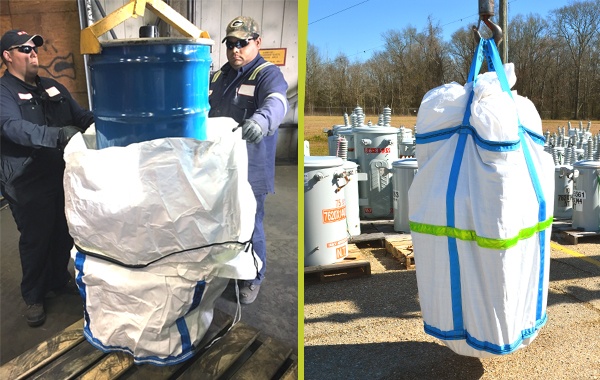Realizing significant cost savings in packaging hazardous wastes for disposal by utilizing FIBCs in lieu of rigid IBCs. When considering packaging methods for hazardous wastes, many people focus on just one number - the cost of the disposal unit itself. This is often shortsighted, as significant cost savings can be realized in many other places. A holistic approach should be utilized in properly evaluating hazardous waste disposal options.
The goal is to find a disposal solution that meets your specific performance criteria at the lowest overall cost while keeping you in regulatory compliance. For many hazardous waste streams, that solution is often a FIBC that meets the standards of 49 CFR 178.700. PacTec offers a flexible, multi-layered “Y” UN-rated overpack bag that has saved its’ customers thousands of dollars.
PacTec’s cylindrical TransPac® FIBC carries a “Y” UN-Rating, making it an ideal packaging solution for the transport and disposal of many hazardous wastes. The proprietary design is the first in the industry to utilize a zipper closure for ease of use in the field. This FIBC offers many advantages over rigid IBCs in addition to a significant cost savings.
Advantages:
- More economical than metal drums
- Self-supporting material holds bag open for easy, one-person loading
- Fully lined with absorbent material for maximum spill control
- Lightweight and compact
- Requires fewer personnel and machinery resources to deploy
Applications:
- Pole-Mounted Transformers
- -37.5 kVA, 50 kVA, Small 75 kVA
- VOC contaminated equipment
- Spent Carbon Canisters
- Safe transport of PCB’s
- Storm Preparedness
Features:
- “Y” UN Rating for Pkg Group II
- DOT Compliant
- Easy to use* zipper closure
- Bright white bag with reflective
- striping for safety
- Integrated industrial lifting straps

5 Ways You Realize Significant Cost Savings
1. Material Savings
The easiest costs to compare are the actual packaging material costs. For the amount of materials it holds and the opening size, FIBCs are often times far less expensive than traditional IBCs. For example, a 100 gallon steel open head salvage drum can cost upwards of $400 each, whereby a PacTec FIBC can easily accommodate the same dimensions for nearly half of that cost. Better yet, because of the dimensions of the PacTec FIBC, it can replace 85- and 95-gallon drums, all at a lower price. It’s easy to recognize significant cost savings as the volume of FIBCs increase while traditional IBC use decreases.
2. Storage Space Savings
IBCs like metal or PE drums are rigid by design and take up valuable cubic footage space in your storage/staging areas. Often times, a single unit occupies an entire pallet space compared to up to 70 FIBCs with the same content capacity. For remediation companies requiring a unit on fleet vehicles for spill response, the space savings is significantly noticeable. Furthermore, DOT requires hazardous waste haulers to keep an overpack on trucks/trailers.
3. Transport Space Savings
Transportation costs for hazardous materials can escalate quickly, so comparing these expenses for FIBCs vs traditional methods is important. Considering the footprint, you may be able to get 2 85-gallon drums onto a pallet, where you can easily fit 3-4 full FIBCs in the same pallet space. You realize even more savings if you are currently using drums or larger IBCs.
4. Man-hour/Efficiency Savings
The amount of time it takes to respond to a spill or to contain hazardous waste can vary depending on the packaging methods used. Consideration should be given to the types and availability of necessary equipment while in the field and how cumbersome packages are to deploy. Do you have access to a forklift with operator and spotter, drum claws or drum dolly? Many overpack methods are very cumbersome, but the FIBC, as a multi-layer single unit with zipper closure is often easier to handle and deploys in moments. Plus, the integrated lifting straps reduce the necessary equipment and accessories needed to handle the loaded waste. This simple reduction in response time can translate to additional opportunities and income.
5. Safety Savings
When loading hazardous waste drums vertically into an IBC, standard operational methods require the use of a forklift with operator and drum claws/straps for containerization. Following containerization, the overpack cannot be moved via a standard drum dolly due to size and weight, so the same needs are required for repeating the process. When using drum claws to move overpacks, there is an increased risk of the dropping the unit due to the inner drum shifting. There is also a risk of the unit swinging while being moved, creating another hazard of striking/crushing the spotter (if one is helping the fork operator). More pallets are also needed to stage the overpacks for transportation.
In contrast, when an FIBC is utilized to load hazardous waste drums, once the drum is loaded, the unit can be moved via the integrated lifting straps. This mitigates the drop, swing and spotter impact because the lifting straps afford positive pressure when the bag is picked up. A standard drum dolly can also be utilized to move the "bagged" drum around because it fits in the toes of the dolly and the drum lock can then be placed on the ring.
PacTec maintains a supply of the bags above for immediate shipment, but can custom manufacture a solution to meet your job specifications. To discuss your project needs or to order TransPacs® - give one of our knowledgeable sales professionals a call today at 1-800-272-2832.




